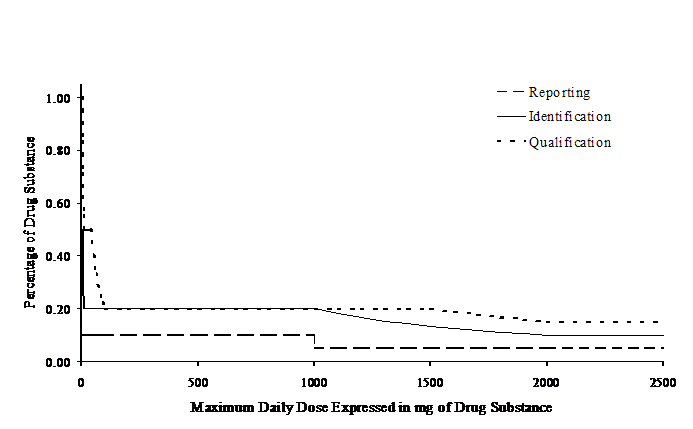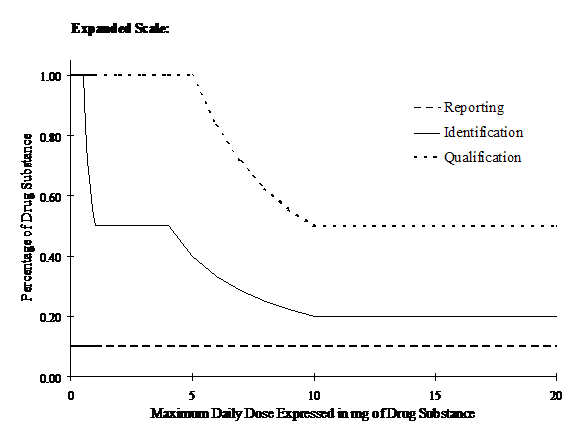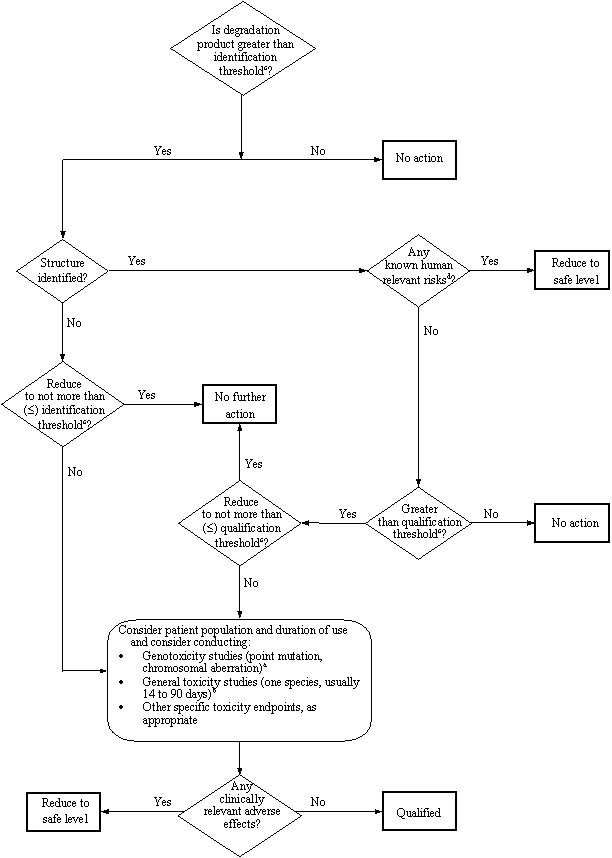 |
 |
 |
 |
 | |||||
| |||||||||
|
|
|
|
|
Guidance for Industry (PDF version of this document) U.S. Department of Health and Human Services July 2006 Guidance for Industry Additional copies are available from: Office of Training and Communication or Office of Communication, Training and U.S. Department of Health and Human Services July 2006 Revision 2 TABLE OF CONTENTS
I. INTRODUCTION (1.0) Guidance for Industry
I. INTRODUCTION (1.0)This guidance provides recommendations for registration applications on the content and qualification of impurities in new drug products produced from chemically synthesized new drug substances not previously registered in a region or member state. This guidance revises the ICH guidance of the same title that was issued in May 1997 and first revised in February 2003. The first revision clarified the 1997 guidance and included other changes. The revision also provided consistency with more recently published ICH guidances (e.g., Q3A(R) Impurities in New Drug Substances, Q3C Impurities: Residual Solvents, and Q6A Specifications: Test Procedures and Acceptance Criteria for New Drug Substances and New Drug Products: Chemical Substances). This second revision provides clarification to Attachment 2. This guidance complements the ICH Q3A(R) guidance, which should be consulted for basic principles along with ICH Q3C when appropriate. This guidance addresses only those impurities in new drug products classified as degradation products of the drug substance or reaction products of the drug substance with an excipient and/or immediate container closure system (collectively referred to as degradation products in this guidance). Generally, impurities present in a new drug substance need not be monitored or specified in new drug product unless they are also degradation products (see ICH Q6A guidance on specifications). Impurities arising from excipients present in a new drug product or extracted or leached from the container closure system are not covered by this guidance. This guidance also does not apply to new drug products used during the clinical research stages of development. The following types of products are not covered in this guidance:
Also excluded from this document are (1) extraneous contaminants that should not occur in new drug products and are more appropriately addressed as good manufacturing practice (GMP) issues, (2) polymorphic forms, and (3) enantiomeric impurities. FDA's guidance documents, including this guidance, do not establish legally enforceable responsibilities. Instead, guidances describe the Agency's current thinking on a topic and should be viewed only as recommendations, unless specific regulatory or statutory requirements are cited. The use of the word should in Agency guidances means that something is suggested or recommended, but not required. II. RATIONALE FOR THE REPORTING AND CONTROL OF DEGRADATION PRODUCTS (2.0)The applicant should summarize the degradation products observed during manufacture and/or stability studies of a new drug product. This summary should be based on sound scientific appraisal of potential degradation pathways in the new drug product and impurities arising from the interaction with excipients and/or the immediate container closure system. In addition, the applicant should summarize any laboratory studies conducted to detect degradation products in the new drug product. This summary also should include test results of batches manufactured during the development process and batches representative of the proposed commercial process. A rationale should be provided for exclusion of those impurities that are not degradation products (e.g., process impurities from the drug substance and impurities arising from excipients). The impurity profiles of the batches representative of the proposed commercial process should be compared with the profiles of batches used in development, and any differences should be discussed. Any degradation product observed in stability studies conducted at the recommended storage condition should be identified when present at a level greater than (>) the identification thresholds given in Attachment 1. When identification of a degradation product is infeasible, a summary of the laboratory studies demonstrating the unsuccessful efforts to identify it should be included in the registration application. Degradation products present at a level of not more than (£) the identification threshold generally would not need to be identified. However, analytical procedures should be developed for those degradation products that are suspected to be unusually potent, producing toxic or significant pharmacological effects at levels not more than (£) the identification threshold. In unusual circumstances, technical factors (e.g., manufacturing capability, a low drug substance to excipient ratio, or the use of excipients that are crude products of animal or plant origin) can be considered part of the justification for selection of alternative thresholds based on manufacturing experience with the proposed commercial process.
III. ANALYTICAL PROCEDURES (3.0)The registration application should include documented evidence that the analytical procedures have been validated and are suitable for the detection and quantitation of degradation products (see ICH Q2A and Q2B guidances on analytical validation). In particular, analytical procedures should be validated to demonstrate specificity for the specified and unspecified degradation products. As appropriate, this validation should include samples stored under relevant stress conditions: light, heat, humidity, acid/base hydrolysis, and oxidation. When an analytical procedure reveals the presence of other peaks in addition to those of the degradation products (e.g., the drug substance, impurities arising from the synthesis of the drug substance, excipients and impurities arising from the excipients), these peaks should be labeled in the chromatograms and their origin(s) discussed in the validation documentation. The quantitation limit for the analytical procedure should be not more than (£) the reporting threshold. Degradation product levels can be measured by a variety of techniques, including those that compare an analytical response for a degradation product to that of an appropriate reference standard or to the response of the new drug substance itself. Reference standards used in the analytical procedures for control of degradation products should be evaluated and characterized according to their intended uses. The drug substance can be used to estimate the levels of degradation products. In cases when the response factors are not close, this practice can still be used if a correction factor is applied or the degradation products are, in fact, being overestimated. Acceptance criteria and analytical procedures, used to estimate identified or unidentified degradation products, are often based on analytical assumptions (e.g., equivalent detector response). These assumptions should be discussed in the registration application. Differences between the analytical procedures used during development and those proposed for the commercial product should also be discussed. IV. REPORTING DEGRADATION PRODUCTS, CONTENT OF BATCHES (4.0)Analytical results should be provided in the registration application for all relevant batches of the new drug product used for clinical, safety, and stability testing, as well as batches that are representative of the proposed commercial process. Quantitative results should be presented numerically, and not in general terms such as “complies”, “meets limit.” Any degradation product at a level greater than (>) the reporting threshold (see Attachment 1), and total degradation products observed in the relevant batches of the new drug product, should be reported with the analytical procedures indicated. Below 1.0 percent, the results should be reported to the number of decimal places (e.g., 0.06 percent) in the applicable reporting threshold; at and above 1.0 percent, the results should be reported to one decimal place (e.g., 1.3 percent). Results should be rounded using conventional rules (see Attachment 2). A tabulation (e.g., spreadsheet) of the data is recommended. Degradation products should be designated by code number or by an appropriate descriptor (e.g., retention time). If a higher reporting threshold is proposed, it should be fully justified. All degradation products at a level greater than (>) the reporting threshold should be summed and reported as total degradation products.
V. LISTING OF DEGRADATION PRODUCTS IN SPECIFICATIONS (5.0)
VI. QUALIFICATION OF DEGRADATION PRODUCTS (6.0)
Qualification is the process of acquiring and evaluating data that establishes the biological safety of an individual degradation product or a given degradation profile at the levels specified. The applicant should provide a rationale for establishing degradation product acceptance criteria that includes safety considerations. The level of any degradation product present in a new drug product that has been adequately tested in safety and/or clinical studies would be considered qualified. Therefore, it is useful to include any available information on the actual content of degradation products in the relevant batches at the time of use in safety and/or clinical studies. Degradation products that are also significant metabolites present in animal and/or human studies are generally considered qualified. Degradation products could be considered qualified at levels higher than those administered in safety studies based on a comparison between actual doses given in the safety studies and the intended dose of the new drug product. Justification of such higher levels should include consideration of factors such as: (1) the amount of degradation product administered in previous safety and/or clinical studies and found to be safe; (2) the increase in the amount of the degradation product; and (3) other safety factors, as appropriate. If the qualification thresholds given in Attachment 1 are exceeded and data are unavailable to qualify the proposed acceptance criterion of a degradation product, additional studies to obtain such data may be appropriate (see Attachment 3). Higher or lower thresholds for qualification of degradation products may be appropriate for some individual new drug products based on scientific rationale and level of concern, including drug class effects and clinical experience. For example, qualification can be especially important when there is evidence that such degradation products in certain new drug products or therapeutic classes have previously been associated with adverse reactions in patients. In these instances, a lower qualification threshold may be appropriate. Conversely, a higher qualification threshold may be appropriate for individual new drug products when the level of concern for safety is less than usual based on similar considerations (e.g., patient population, drug class effects, and clinical considerations). Proposals for alternative thresholds would be considered on a case-by-case basis. The Decision Tree for Identification and Qualification of a Degradation Product (Attachment 3) describes considerations for the qualification of degradation products when thresholds are exceeded. In some cases, reducing the level of degradation product (e.g., use of a more protective container closure or modified storage conditions) to not more than (£) the threshold can be simpler than providing safety data. Alternatively, adequate data could be available in the scientific literature to qualify a degradation product. If neither is the case, additional safety testing should be considered. The studies considered appropriate to qualify a degradation product will depend on a number of factors, including the patient population, daily dose, and route and duration of new drug product administration. Such studies can be conducted on the new drug product or substance containing the degradation products to be controlled, although studies using isolated degradation products can sometimes be appropriate. Although this guidance is not intended to apply during the clinical research stage of development, in the later stages of development, the thresholds in this guidance may be useful in evaluating new degradation products observed in new drug product batches prepared by the proposed commercial process. Any new degradation product observed in later stages of development should be identified (see the Decision Tree for Identification and Qualification of a Degradation Product in Attachment 3) if its level is greater than (>) the identification threshold given in Attachment 1. Similarly, qualification of the degradation product should be considered if its level is greater than (>) the qualification threshold given in Attachment 1. Safety studies should provide a comparison of results of safety testing of the new drug product or drug substance containing a representative level of the degradation product with previously qualified material, although studies using the isolated degradation products can also be considered. Glossary
Degradation Product: An impurity resulting from a chemical change in the drug substance brought about during manufacture and/or storage of the new drug product by the effect of, for example, light, temperature, pH, water, or by reaction with an excipient and/or the immediate container closure system Degradation Profile: A description of the degradation products observed in the drug substance or drug product Development Studies: Studies conducted to scale-up, optimize, and validate the manufacturing process for a drug product Identification Threshold: A limit above (>) which a degradation product should be identified Identified Degradation Product: A degradation product for which a structural characterization has been achieved Impurity: Any component of the new drug product that is not the drug substance or an excipient in the drug product New Drug Substance: The designated therapeutic moiety that has not been previously registered in a region or member state (also referred to as a new molecular entity or new chemical entity). It can be a complex, simple ester, or salt of a previously approved substance. Qualification: The process of acquiring and evaluating data that establishes the biological safety of an individual degradation product or a given degradation profile at the levels specified Qualification Threshold: A limit above (>) which a degradation product should be qualified Reporting Threshold: A limit above (>) which a degradation product should be reported Specified Degradation Product: A degradation product that is individually listed and limited with a specific acceptance criterion in the new drug product specification. A specified degradation product can be either identified or unidentified Unidentified Degradation Product: A degradation product for which a structural characterization has not been achieved and that is defined solely by qualitative analytical properties (e.g., chromatographic retention time) Unspecified Degradation Product: A degradation product that is limited by a general acceptance criterion, but not individually listed with its own specific acceptance criterion, in the new drug product specification ATTACHMENT 1THRESHOLDS FOR DEGRADATION PRODUCTS Reporting Thresholds
Identification Thresholds
Qualification Thresholds
1 The amount of drug substance administered per day Illustration of Thresholds for Reporting, Identification, and Qualification of Degradation
Attachment 2ILLUSTRATION OF REPORTING DEGRADATION PRODUCT RESULTS FOR IDENTIFICATION AND QUALIFICATION IN AN APPLICATION The attachment is only illustrative and is not intended to serve as a template for how results on degradation products should be presented in an application file. Normally raw data are not provided. Example 1: 50 mg Maximum Daily Dose Reporting threshold: 0.1%
Example 2: 1.9 gram Maximum Daily Dose Reporting threshold: 0.05%
Notes on Attachment 2 1 After identification, if the response factor is determined to differ significantly from the original assumptions, it can be appropriate to re-measure the actual amount of the degradation product present and re-evaluate against the qualification threshold (see Attachment 1). 2 To verify if a threshold is exceeded, a reported result should be evaluated against the thresholds as follows: When the threshold is described in %, the reported result rounded to the same decimal place as the threshold should be compared directly to the threshold. When the threshold is described in TDI, the reported result should be converted to TDI, rounded to the same decimal place as the threshold, and compared to the threshold (e.g., an amount of 0.18% degradation level corresponds to a TDI of 3.4 mg impurity (absolute amount), which is then rounded down to 3 mg; so the qualification threshold expressed in TDI (3 mg) is not exceeded).
Attachment 3DECISION TREE FOR IDENTIFICATION AND QUALIFICATION OF A DEGRADATION PRODUCT
Notes to Attachment 3 a If considered desirable, a minimum screen (e.g., genotoxic potential), should be conducted. A study to detect point mutations and one to detect chromosomal aberrations, both in vitro, are considered an appropriate minimum screen. This guidance was developed within the Q3B(R) Expert Working Group of the International Conference on Harmonisation of Technical Requirements for Registration of Pharmaceuticals for Human Use (ICH) and has been subject to consultation by the regulatory parties, in accordance with the ICH process. This document was endorsed by the ICH Steering Committee at Step 4 of the ICH process, June 2, 2006. At Step 4 of the process, the final draft is recommended for adoption to the regulatory bodies of the European Union, Japan, and the United States. Arabic numbers reflect the organizational breakdown in the document endorsed by the ICH Steering Committee at Step 4 of the ICH process. For example, addressing reporting, identification, and qualification thresholds; listing impurities in specifications and making a clear distinction between ICH Q3B (listing impurities) and Q6A (setting specifications); and deleting the exception to conventional rounding practice (i.e., the provision recommending no rounding up to 0.1 percent for values between 0.05 and 0.09 percent).
Date created: August 3, 2006 |
|||||||||||||||||||||||||||||||||||||||||||||||||||||||||||||||||||||||||||||||||||


